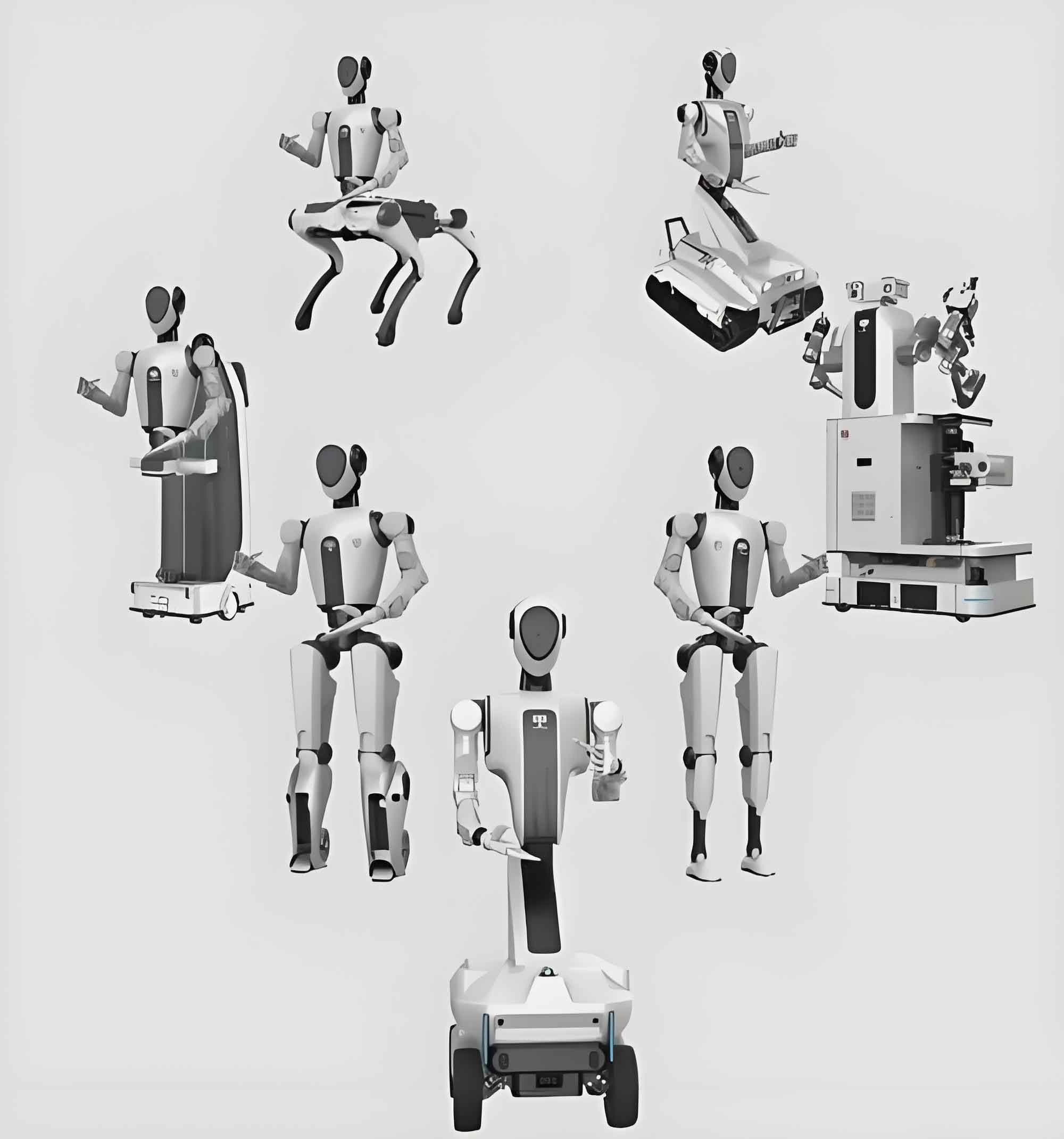1. Introduction
The rapid advancement of industrial automation demands intelligent systems capable of operating in complex, dynamic environments. Traditional inspection robots often struggle with adaptability, efficiency, and collaboration, particularly in scenarios such as aircraft maintenance, infrastructure monitoring, and industrial safety checks. To address these challenges, this study proposes an embodied AI robot framework that integrates multimodal data fusion, cloud-edge collaboration, and heterogeneous multi-robot coordination. By leveraging embodied large models, the system achieves real-time anomaly detection, adaptive decision-making, and scalable task execution, significantly enhancing inspection accuracy and operational efficiency.

2. System Architecture and Key Components
The proposed framework comprises three core modules:
- Real-Time Detection Algorithms
- Cloud-Edge Collaborative Workflow
- Heterogeneous Multi-Robot Coordination
2.1 Real-Time Detection Algorithms
Real-time detection is achieved through multimodal sensor fusion, lightweight feature extraction, and anomaly detection.
Multimodal Data Fusion
Sensors (RGB cameras, LiDAR, ultrasonic flaw detectors, and infrared thermal imagers) generate heterogeneous data streams. A spatial adaptive fusion algorithm combines these inputs to construct a unified environmental model. Let DD represent the fused dataset:D=∑i=1nαi⋅Si+β⋅CD=i=1∑nαi⋅Si+β⋅C
where SiSi denotes sensor inputs, αiαi are fusion weights, and CC represents contextual data (e.g., material properties).
Lightweight Feature Extraction
Deploying compressed models (e.g., MobileNet with depthwise separable convolutions) enables rapid feature extraction under resource constraints. The feature extraction process is optimized as:F=ReLU(W⋅X+b)F=ReLU(W⋅X+b)
where WW and bb are learnable parameters, and XX is the input tensor.
Anomaly Detection
Local models identify critical anomalies (e.g., cracks >2mm, corrosion >5%) using threshold-based rules:Alert={1if DefectScore≥τ0otherwiseAlert={10if DefectScore≥τotherwise
Here, ττ is dynamically adjusted based on environmental conditions.
2.2 Cloud-Edge Collaborative Workflow
The system balances low-latency edge processing with cloud-based high-precision analysis.
Edge Layer
- Tasks: Real-time data preprocessing, preliminary anomaly detection.
- Advantages: Sub-500ms latency, bandwidth optimization.
Cloud Layer
- Tasks: Deep learning-based anomaly verification, historical data analysis, model retraining.
- Advantages: High-resolution defect classification, elastic compute scaling.
Data Transmission Protocol
To minimize latency, a hybrid protocol combines data compression and encryption:Ttotal=Tprocess+DcompressedB+TencryptTtotal=Tprocess+BDcompressed+Tencrypt
where BB is bandwidth and DcompressedDcompressed is compressed data size.
2.3 Heterogeneous Multi-Robot Coordination
The embodied AI robot framework employs distributed decision-making and dynamic task allocation for scalable operations.
Dynamic Task Allocation
A greedy algorithm optimizes resource utilization:Cost(Ri,Tj)=w1⋅Distance(Ri,Tj)+w2⋅Workload(Ri)Cost(Ri,Tj)=w1⋅Distance(Ri,Tj)+w2⋅Workload(Ri)
Robots RiRi are assigned tasks TjTj to minimize total cost.
Collaborative Perception
Distributed sensors form a global perception network. The fused perception output PP is:P=⋃k=1mPk⋅γkP=k=1⋃mPk⋅γk
where PkPk is local perception data and γkγk denotes confidence weights.
3. Experimental Validation and Results
3.1 Implementation in Aviation Scenarios
The system was tested on 25 aircraft at Nanjing Lukou International Airport. Key metrics include:
| Metric | Value |
|---|---|
| Crack Detection Accuracy | 98.2% |
| Corrosion Detection Rate | 95.6% |
| Average Response Time | 6 seconds |
| False Positive Rate | <1.5% |
Efficiency Gains
- 60% faster than manual inspections.
- 32% higher precision in defect localization.
3.2 Cloud-Edge Synergy Analysis
The hybrid model reduced bandwidth usage by 45% while maintaining 99.8% data integrity.
Resource Utilization Comparison
| Parameter | Edge-Only | Cloud-Only | Hybrid |
|---|---|---|---|
| Latency (ms) | 500 | 2500 | 600 |
| Compute Cost ($/hr) | 0.8 | 4.2 | 1.5 |
| Accuracy (%) | 85.3 | 97.8 | 96.4 |
4. Mathematical Formulation of Key Algorithms
4.1 Adaptive Multimodal Fusion
The fusion algorithm dynamically adjusts weights αiαi based on sensor reliability:αi=Confidence(Si)∑j=1nConfidence(Sj)αi=∑j=1nConfidence(Sj)Confidence(Si)
4.2 Distributed Path Planning
Multi-robot path planning avoids collisions via potential field optimization:Utotal=Uattractive+UrepulsiveUtotal=Uattractive+UrepulsiveUattractive=12k⋅∥x−xgoal∥2Uattractive=21k⋅∥x−xgoal∥2Urepulsive=∑jQ∥x−xj∥2Urepulsive=j∑∥x−xj∥2Q
5. Conclusion
This study presents a groundbreaking embodied AI robot system that synergizes edge intelligence, cloud computing, and multi-robot coordination to overcome the limitations of traditional inspection systems. Key innovations include:
- A lightweight-edge and cloud-based hybrid architecture for real-time and high-precision analytics.
- A dynamic task allocation framework for heterogeneous multi-robot teams.
- Multimodal fusion algorithms that enhance environmental perception.
Experimental results in aviation scenarios validate the system’s ability to improve inspection efficiency by 60%, reduce labor costs by 40%, and achieve sub-second response times. Future work will extend this framework to underwater and nuclear facility inspections, further demonstrating the versatility of embodied AI robots in industrial automation.
